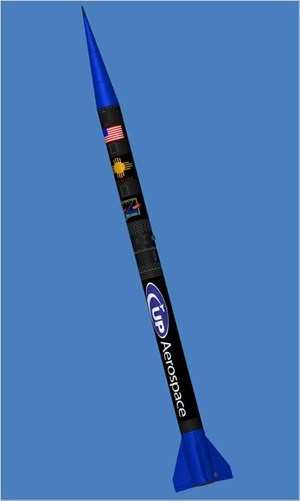Rocket Still Has Not Been Found
 UP Aerospace, Inc.
released its initial analysis Friday of the September 25 flight of
its unmanned SpaceLoft XL vehicle. As Aero-News reported, the
launch -- the first flight from New Mexico's Spaceport America --
went awry about 10 seconds after liftoff, with the rocket falling
back to Earth soon thereafter.
UP Aerospace, Inc.
released its initial analysis Friday of the September 25 flight of
its unmanned SpaceLoft XL vehicle. As Aero-News reported, the
launch -- the first flight from New Mexico's Spaceport America --
went awry about 10 seconds after liftoff, with the rocket falling
back to Earth soon thereafter.
UP Aerospace officials tell ANN that pre-launch activities began
at approximately 5:30 am MDT Monday, for an anticipated launch at
7:30 am. Almost immediately into the pre-launch activities, it was
discovered that the rocket's onboard C-band transponders (the
devices that provide tracking information to radar sites) were not
functioning properly. Over the next two hours the launch team
successfully diagnosed and corrected the issue, which turned out to
be an errant electrical ground.
The launch team then assembled at the Launch Control Center. A
poll of the launch team was unanimous to proceed with the launch
countdown.
The countdown clock was adjusted to a new launch window of
between 2:00 and 2:30 PM. The entire countdown proceeded absolutely
flawlessly, and built-in optional "holds" were not required.
The SpaceLoft XL launched at 2:14 PM Mountain Time. The vehicle
was rapidly picked up by three radars at the White Sands Missile
Range, proving that the morning fix of the C-band transponders was
successful -- and that the "GO" for launch by the team was the
correct decision.
The vehicle was intended to fly beyond the international
definition of space (100km or 62 miles), with a final anticipated
apogee of 365,000 feet or 69.1 miles in 155 seconds. The vehicle
flew on a flawless trajectory for nine seconds, reaching an
altitude of 24,000 feet. At that point, however, an anomaly
occurred.
The anomaly caused a wobble in the vehicle's flight trajectory.
The vehicle continued upward, reaching a peak altitude of 42,000
feet. The vehicle then returned to earth, unpowered, landing in the
New Mexico desert. Radar track was lost approximately 2,000 feet
above the desert floor.
To date, the rocket and its cargo of 50 science experiments and
other payloads have not been recovered. UP Aerospace and Spaceport
America personnel are continuing to search for the vehicle...
hindering efforts to positively identify what went wrong.
"We're certainly anxious to characterize the anomaly that
occurred," said Jerry Larson, President of UP Aerospace. "Our
SpaceLoft XL vehicle was performing precisely as planned, heading
on its exact trajectory to space. All systems were fine until nine
seconds into the flight."
"We're sifting through data from three radar sites, piecing
together valuable information and performing the needed flight
analysis," Larson added. "We're simultaneously searching rugged
terrain to get to the vehicle's landing point. Once all of the air
and ground data are assembled and processed, we'll know exactly
what happened -- and make whatever corrections are necessary for
the next flight."
Larson further added, "Until all facts are assembled, all
possibilities remain on the table. However, from what we've seen so
far, and how well the vehicle was performing until the anomaly, we
would be extremely surprised if we discover a major issue. We're
looking forward to identifying the anomaly, correcting it, and
proceeding with the space-flight missions on our launch
calendar."
Eric Knight, CEO of UP Aerospace, said, "We've been so flooded
with positive and encouraging e-mails from around the world that
our e-mail servers can barely process them. Keeping in the sprit of
this new public era of space flight, we will keep our launch
partners and the public fully informed our analysis. Our
investigation and corrective actions will be an open book."
Knight added that, despite the loss of the rocket, the launch
was successful "on many, many fronts."
"We proved that a private company can team up with multiple
entities -- in this case, Spaceport America, White Sands Missile
Range, the FAA, and regional and government land owners -- and
successfully conduct a space launch," Knight said. "We're even more
excited about the future than we were before the launch. We will
correct the issue with the rocket and be back on the launch pad,
counting down for another space launch, very soon."
UP Aerospace has up to 30 space launches per year scheduled from
New Mexico's "Spaceport America". The company says the SpaceLoft XL
vehicle can launch up to 110 pounds (50 kilograms) of scientific,
educational, and entrepreneurial payloads into space, with an
altitude capability of up to 140 miles (225 kilometers).
 ANN's Daily Aero-Term (04.20.24): Light Gun
ANN's Daily Aero-Term (04.20.24): Light Gun Aero-News: Quote of the Day (04.20.24)
Aero-News: Quote of the Day (04.20.24) ANN's Daily Aero-Linx (04.21.24)
ANN's Daily Aero-Linx (04.21.24) Aero-News: Quote of the Day (04.21.24)
Aero-News: Quote of the Day (04.21.24) ANN's Daily Aero-Term (04.21.24): Aircraft Conflict
ANN's Daily Aero-Term (04.21.24): Aircraft Conflict



